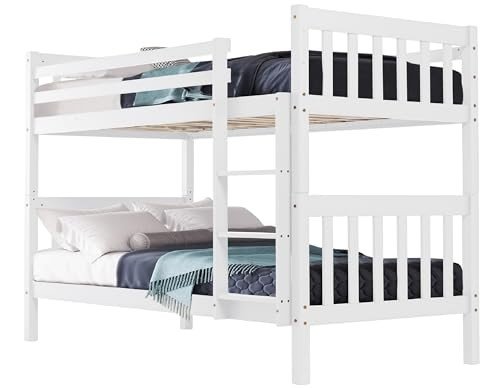Exploring Bunk Beds: A Comprehensive Guide
Bunk beds have actually long been a staple in children's bedrooms, dormitories, and even homes with minimal space. Not only do they provide a useful sleeping solution, however they likewise create an enjoyable and imaginative environment for kids and a great space-saver for adults and households. talks about it will explore whatever you need to know about bunk beds, from types and materials to safety tips and purchasing advice.
Table of Contents
- Kinds Of Bunk Beds
- Standard Bunk Beds
- Loft Beds
- Triple Bunk Beds
- L-Shaped Bunk Beds
- Material Options
- Wood
- Metal
- Security Considerations
- Purchasing Guide
- FAQs
Types of Bunk Beds
Bunk beds can be found in numerous designs to fit various needs and choices. Here's a breakdown of the most common types:
Conventional Bunk Beds
Traditional bunks typically include 2 beds stacked vertically on top of one another. These beds are perfect for brother or sisters sharing a room or for optimizing sleeping space in visitor spaces.
Loft Beds
Loft beds stand likewise to conventional bunk beds however do not have a lower sleeping location. Instead, they typically include a desk or seating location beneath, making them a great choice for little spaces needing multifunctionality.
Triple Bunk Beds
Triple bunk beds are developed for 3 occupants, with beds stacked in a three-tier setup. These are less typical however can be a fun option for large households or slumber parties.
L-Shaped Bunk Beds
With one bed positioned horizontally and the other vertically, L-shaped bunk beds are typically equipped with extra features such as desks or storage drawers and can complement corner areas in a room.
Comparison of Bunk Bed Types
| Bed Type | Suitable Use | Description |
|---|---|---|
| Traditional | Shared bed rooms or guest spaces | Two beds stacked vertically |
| Loft | Little spaces needing multi-purpose space | Upper bed with open space below |
| Triple | Large families or sleepovers | Three beds stacked vertically |
| L-Shaped | Corner or flexible spaces | A combination of vertical and horizontal beds |
Material Options
Bunk beds are manufactured from various products, with wood and metal being the most typical. Each product has its pros and cons.
Wood
- Durability: Generally robust and can stand up to years of usage.
- Visual Appeal: Offers a timeless look that can blend with various decorations.
- Weight Capacity: Typically stronger; can support much heavier weights.
- Downsides: May be more pricey than metal alternatives and can be susceptible to scratches.
Metal
- Strength: Generally light-weight and simple to move but still strong.
- Modern Design: Often comes in smooth designs, making it appealing for contemporary areas.
- Cost-efficient: Usually more economical than wood alternatives.
- Disadvantages: Can be cold to the touch in winter seasons and might not have the very same visual appeal for some buyers.
Security Considerations
When it concerns bunk beds, safety can not be ignored. Here are essential security ideas to keep in mind:
- Guardrails: Ensure that the leading bunk has guardrails on both sides to prevent falls.
- Strong Construction: Check for a strong develop and strong materials to stand up to weight and motion.
- Weight Limit: Adhere to the maker's weight limitation for both the upper and lower bunks.
- Ladder Design: Choose bunks with a safe, easy-to-climb ladder and prevent any sharp edges or rungs.
- Age Restrictions: Most producers advise that kids under the age of six should not oversleep the upper bunk.
Purchasing Guide
When looking for bunk beds, think about the following aspects to find the best fit for your needs:
- Space Availability: Measure the space size and ceiling height, ensuring there is appropriate space for the leading bunk.
- Bed Size: Decide in between twin, complete, or bigger sizes based upon your needs and the size of the space.
- Design Preference: Consider the total decoration of the bedroom to discover a suitable style.
- Alleviate of Setup: Look for a bunk bed that is uncomplicated to assemble.
- Budget plan: Bunk beds are available in numerous rate ranges, so identify a budget plan before starting your search.
Frequently asked questions
1. What is the recommended age for children to sleep on the top bunk?
Kids aged 6 and older are usually advised to sleep on the leading bunk to reduce the risk of falls.
2. How can I make my bunk bed safer?
To improve safety, ensure guardrails are effectively set up and inspect that the bed is placed on a flat surface. In addition, encourage kids to utilize the ladder carefully.
3. Can I transform a bunk bed into 2 separate beds?
Numerous bunk beds are created to be convertible. Inspect the manufacturer's specs for convertibility functions.
4. What accessories are available for bunk beds?
Common accessories include beddings, storage drawers, staircases rather of ladders, and tented canopies for a fun visual appeal.
5. How do I preserve my bunk bed?
Routine look for loose screws or structural integrity can assist ensure safety. Dust the bed regularly and clean spills promptly to keep the products in good condition.
Bunk beds are flexible and a space-efficient option for numerous living situations, from kids's rooms to visitor lodgings. With numerous styles and materials available, potential buyers have a wealth of alternatives to think about, making sure a mix of functionality and visual appeals. By prioritizing safety and following the tips described in this guide, individuals can discover the ideal bunk bed that fits their space and lifestyle, all while developing an enjoyable sleeping environment.

